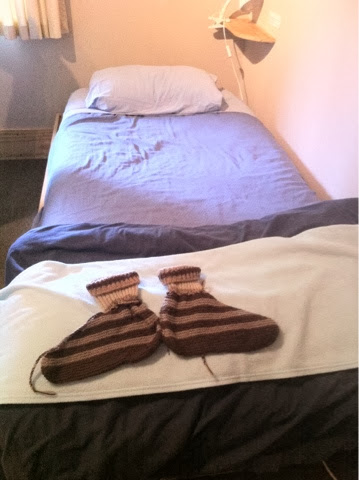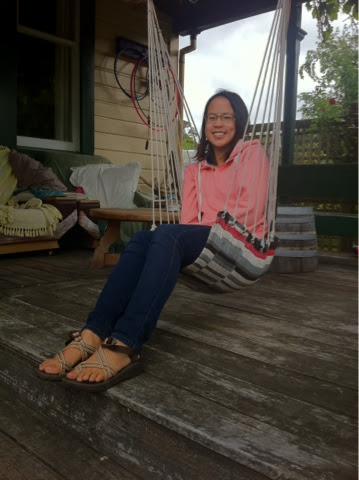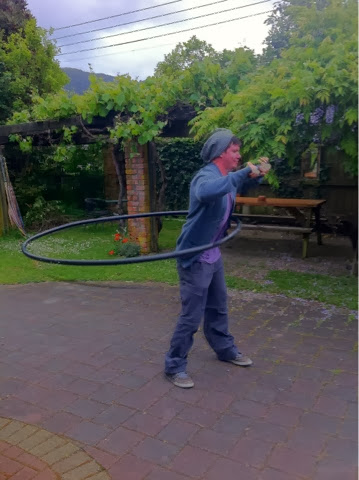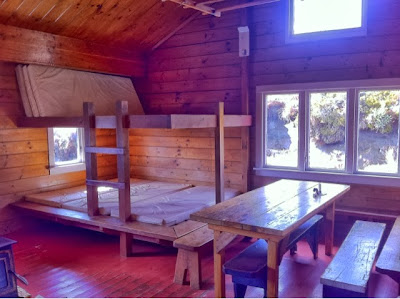Michelle: The Tongariro Alpine Crossing is supposed to be New Zealand's greatest day walk, and it delivered!
Our day started at 7:15 am on the
Tongariro Expeditions shuttle bus from the holiday park we were working at. Jarod, the driver and owner, was quite possibly the most enthusiastic person I'd ever met. He made the short bus ride so exciting and genuinely loved what he was doing. Within minutes of meeting Dave and I, he offered up his place in Taupo because Dave mentioned he wanted to try the trout fishing in Lake Taupo.
Dave: Jarod was also quite the showman on the buses PA system. In Jarod's words seeing Mt.Taranaki in the distance was 'the shizzle', the day was going to be a 'stunna' and just about every was 'sweet as'. He also mentioned to me how much he loves the Tongariro area. Jarod was quite open and mentioned that he had buried both of his children's afterbirth (placenta and umbilical cords) beneath trees of significance. I found this very interesting and I did a little Google search and it's a Maori practice that is suppose to establish a connection between the newborn child and the land of their birth. I find it interesting how much the Maori culture has permeated the dominant western culture here. In Canada I think it would be fair to say it would be very rare to hear about any non-first nation person practicing rituals of the First Nations people.
Michelle: I think that is one of the most amazing thing we have discovered about Kiwis, they are genuinely nice, honest and trusting. We've been treated so well by everyone we've met, offered beer, wine, food, coffee and shelter!
It was a beautiful, clear day, and the temperature was tolerable. From the beginning of the track, we could see Mount Taranaki off in the distance, on the west coast of New Zealand.
Because a storm was forecasted for later in the afternoon, Jarod recommended everyone skip the side trips to the summits of Mount Tongariro and Mount Ngauruhoe. We decided to take his expert advice, as he'd been shuttling people to and from the walks for twenty years.
 |
| The beginning of the walk. Mount Ngauruhoe is right in front of us. This was taken a week and a half before we did the entire walk, so there is more snow. |
The trail starts off pretty flat. The first hour is a nice walk with some beautiful scenery. The board walks made it even nicer. Just like their roads, the boardwalks never allowed us to actually walk in a straight line for very long. After that, the fun really begins. The next section is called the Devil's staircase. It takes about an hour to do, and yes, it is all stairs!
 |
Near the summit of the crossing. Mount Ngauruhoe is behind us with considerably less snow than a week and a half ago! It was quite cold and windy up here! Also note how inflated our pants look, it's because of the rip roaring gail force winds.
|
Once you reach the top of the Devil's Staircase, you pass by the base of Mount Ngauruhoe, which is about a 3 hour side trip. You can only do it safely on a clear day. Clouds surround the peak quickly and make the trail very dangerous due to poor visibility. It is all scree, and apparently, many people have been hurt by falling rocks and lost their way due to the poor weather.
After that you cross the South Crater, which is a vast, flat, muddy bowl-like area. It was also once an active volcanic area. Afterwards, you start climbing again, this time on a ridge. There was considerably less snow on the ridge this time, but it was much windier! It was supposed to be 35 km/h winds, but it felt like more... Dave and I both forgot our gloves too!
 |
| Almost at the summit and feeling very cold. |
At this point, I was feeling a little panicky. The trail still had some ice on it, and it was quite narrow on the ridge. My hands were hurting because it was so cold, and I had to decide between having my hands in my pockets or using my poles to help me stay upright. With the windchill, it got down to minus nine degrees and it definitely caught Dave and I a little off guard.
As you approach the summit, the Red Crater appears to the right. It's basically a big red gaping hole in the earth that was steaming. Unfortunately, it was difficult to capture it all on camera.
 |
| Watch out for those eruptions! |
 |
| To the right of me is the Red Crater. It is still active, and there were gases (sulphur smelling) being released everywhere. |
Right below you, you can see the Emerald Lakes, and a big blue lake in the distance. This is definitely the highlight of the hike. The views are stunning, and the landscape looks alien-like. This was also the beginning of the descent. The slope to the lake was soft soil, and felt like scree. Dave and I ran down the trail quickly and had lunch down at the bottom.
 |
| Looking down at Emerald Lakes. Dave and I ran down the scree-like surface. It was awesome!! |
To get to Blue Lake, you cross the Central Crater. You can see it behind me in the photo below. The snow in the picture also highlights some old lava flow. It was so unbelievably cool! Once you pass the Blue Lake, you begin the long descent.
 |
| Around kilometer 11. The Red Crater and summit of the crossing is just above my left shoulder. I was so cold, I decided to wear my extra pair of socks as mittens. |
The trail to the Ketetahi carpark passes through some rolling hills and by the Te Mari crater. There is also a backcountry hut that is close. Not sure why, but it looked as if it was damaged when the Te Mari crater erupted. Along the trail, you can see where some pieces of rock landed, and some were quite close to the hut!
The descent seemed endless to Dave and I, and we were also being chased by the storm. Every time we turned around, more and more of the peaks behind us had been engulfed in the clouds.
 |
| In August of 2012, the Te Mari erupted and blew off the top of this hill. It has been steaming ever since! |
 |
View from the descent. You can see Lake Taupo, Lake Rotoraira in the distance. The Te Mari crater is also on the right.
|
Luckily, it did not rain really hard until we reached the end of the trail. My left knee was quite sore by the end of it, and Dave got a wicked blister on his little toe, but other than that, we survived! We started on the trail around 8 am and ended our 19.4 km journey at 2:45 pm. The ascent to the summit was 750 meters, and the descent was a gruelling 1100 meters.
Dave and I agree, this is definitely one of the most beautiful hikes we have ever been on. The changes in landscape as we progressed through the hike were incredible. I highly recommend it to anyone visiting New Zealand!
Makes me wonder what people would consider the best hike in Canada! It's hard for me to choose, and I welcome your opinions! What would you say is the best hike in Canada, or any other country, for that matter?





































